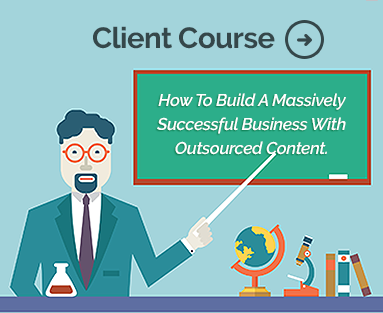Now that you know “why” you need to have great content on your website, this would probably be as good of a time as any to define what awesome writing is in the first place. This section will focus on the most important aspects of content to make it really stand out.
So let’s start with the basics. What makes content good, bad or just plain average? The answer to that question does not come from the writer or even your own opinion. In fact, the only person who could really give us a solid answer is one of your customers.
Why?
Put yourself in your ideal customer’s shoes for a moment. If they are searching for something that your website has to offer, then there is a very good chance that they’re seeking super-specific information that they don’t already know. And if your website can’t answer that specific question, then the odds are pretty darn good that they will end up going to a competitor’s website instead.

Here’s a great example.
I have a friend who was going to be out of town on Valentine’s Day last year. He decided to send his wife some flowers from one of the main online retailers, and he turned to the first brand that most people think of. Things went smoothly at first but once he reached the checkout screen, it gave him the option to add a box of chocolates onto the order for an additional few dollars.
The problem here was that my friend wanted to know if any of the chocolates contained peanuts, because his wife was deathly allergic to them. So he spent the next 5 minutes trying to find an answer. But it wasn’t there…and the more he looked, the more frustrated he became. In fact, it made him so mad that he actually cancelled his purchase at that website, visited two similar sites that also didn’t mention anything about peanuts, and finally bought flowers and candy from retailer #4.
Here’s something critical for you to realize- this friend wasn’t even looking for chocolates in the first place. He just wanted two dozen long-stemmed red roses.
So this retailer lost a locked in, guaranteed sale by omitting one simple sentence from their FAQ page. Just like that. Poof- it’s gone. Regardless if the candy actually had peanuts in it, my friend probably still would have bought the flowers if he hadn’t wasted several minutes looking for the simple answer.

Now would be a great time to ask yourself- how many “box of chocolates” types of questions do your customers have each day that you’re not answering?
You probably think that your website covers absolutely everything that a customer needs to know, but that assumption is almost always wrong. I actually think it’s kind of interesting why this happens-
When you’re an expert at something, it becomes very easy to forget that your customers do not know about your industry like you do. Even the biggest companies make this mistake every single day. Because what you’d consider “common knowledge” may be anything but common to your ideal customer, and executives are almost blinded by it since they would never seek that type of information.
For example, I can tell you after some quick research that the top four fine chocolate manufacturers stopped using peanuts and peanut oils over a decade ago because of food allergies. But just because I know that and the chocolate executives know that, it doesn’t mean a thing when we’re talking about the average customer online. And it would be very easy to omit that little statement on a florist website because we would assume that anyone with peanut allergies would already know the answer. The florist’s ideal customer, however, is probably not the individual with the allergy; it’s his/her friends and family that’s buying a gift.

So once again, take a cold, hard look at your website and make sure your content answers EVERY question a potential customer could have, regardless whether it seems self-explanatory or not.
That’s the core of writing great content.
Think about this- how many times have you searched on your smartphone for the store hours at a local business? If you’re anything like me, you probably do it all the time. But if the store hours aren’t listed, what do you do?
A – Jump in your car and race to the store, hoping it’s open.
B – Call the store directly to ask them when they’re closing.
C – Use your phone to see what other stores are open nearby.
Smartphones have spoiled us so completely that over 58% of the modern world will choose option C; they simply forget their first choice and look for a better option.
Here’s the thing though- all of these problems can be avoided in one incredibly simple step. Just start listening to your customers. They will tell you EXACTLY what kind of content they want to read. In fact, they’re probably already telling you these things through your inbox, on review sites and in forums…you just need to start really listening to know what their “pain points” are.
In case you’re not familiar with that phrase, pain points are the problems that your customers are looking to solve by purchasing your products.
So the first ingredient to great content is writing specifically for your ideal consumer. Got it?

Now let’s talk a little bit about how to ensure that your content is worth reading. That’s the other half of the equation here.
Did you know that your average website visitor reads at an eighth grade level? Combine that with what we discovered earlier about their attention span and you definitely want to ensure that your content is easy to read and quick to get to the point.
What does that mean? Here’s a quick list of bullet points to follow-
- Always start with a great title
- Make the writing conversational
- Keep your sentences short
- Use stories to illustrate points
- Write with basic, everyday words
- Get to the point quickly
- Keep bragging to a minimum
- Use images early and often
- Don’t post long paragraphs
- Focus on great formatting
- Avoid the desire to over-sell
- Have a second set of eyes edit
- Focus solely on the reader
In other words, the writing style used and how you format each page is almost equally important to what you’re actually saying.
If you look back through this lesson, you’ll see that the text is nicely broken up into smaller sections. All the paragraphs as also short and we used photos and bullet points to break things up as well. I did that because every time your eyes transition from one type of formatting to another (a new paragraph, a photo, a heading, a chart, etc.), your mind subconsciously sees it as a stopping point…a rest point, if you will.
So when the text is flowing smoothly with lots of subtle distractions (which our eyes don’t see as distractions at all), you tend to read slower, enjoy the content more and better retain the key information.

But there are also plenty of negative distractions as well…and they don’t always come in the form of swirling patterns of color.
Let’s say I hit you with a sentence like, “The unabashed martinet at the storefront displayed an uncanny panache for his age.”
Using even one of those difficult words in a sentence is enough to derail the most dedicated reader. But by placing them together, you’ll all but guarantee that the visitor will leave the page without second thought. And it’s not just because the words are complex; ANY poorly written sentence in your first few paragraphs would have the exact same effect.
Try this one on for size, which I pulled straight off a major retailer’s homepage- “Arrive by 6 PM on Saturday for our 36 hour annual closeout sale, which features 55% off leading name brand items previously marked for clearance (does not include closeout or super-sale items)!”
In the sentence above, it was meant to convey that there was a 36-hour sale from 6 AM Friday until 6 PM on Saturday. All items would be discounted an additional 55% off the already-low clearance prices, except for the ones tied to other promotions or in the closeout section.
Sounds like an awesome deal, right?
Yet the ad didn’t really manage to say any of that very well in the original text, which is why the promotion probably did horrible. I even called the retail store to double-check that I was deciphering the ad right. The sales clerk said that I was probably the 10th caller that day with the exact same question- imagine how many others didn’t bother calling.
In summary, great content revolves around engaging our readers with text that creates excitement, gives solid answers and conveys a clear message. Every single word should count.


 Previous Lesson
Previous Lesson



Thanks mr.callen love so much this post..